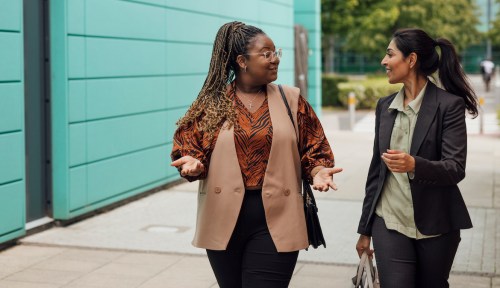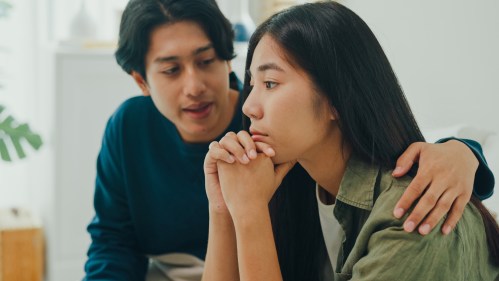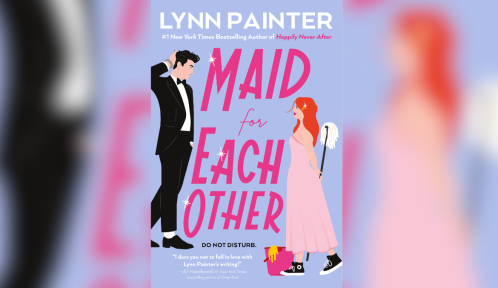How to Be Vulnerable: The Key to Better Relationships, According to Experts
Wondering how to be vulnerable? Relationship experts explain how to overcome a fear of vulnerability and build emotional connections.

When you hear the term “vulnerability,” it may be difficult to pinpoint exactly what it means, as the term applies to several different topics. For instance, a bird’s nest being vulnerable to the rain isn’t exactly the same as your best friend being vulnerable about their recent break up during your lunch hangout. So, you may find yourself wondering what it means to be vulnerable, how to be vulnerable, what the difference is between emotional transparency and emotional vulnerability, and how vulnerability can help you rebuild trust in your relationships.
Experts in This Article
While the idea of being vulnerable can feel intimidating, Dr. Yasmine Saad, PhD, licensed clinical psychologist, founder and CEO of Madison Park Psychological Services, PC, and international best-selling author, reminds us that we have an innate ability to engage in vulnerability as children. “Our job as adults is to find our way back to that playfulness with life,” she explains. “That’s the key to vulnerability. Vulnerability is the ability to be playful. If you can be playful with everything you’re feeling and experiencing in life, you can be vulnerable in your daily life and relationships. The more you practice [vulnerability], the less scared you are about things. It’s a great way to overcome fear,” she continues.
The specific benefits of vulnerability within our relationships are well noted. A 2019 study1 highlights how vulnerability not only makes us feel connected to those around us, it also deepens our relationships. The study found that vulnerability can develop a profound sense of intimacy in our relationships. “Intimacy—a sense of closeness between individuals—is a fundamental component of healthy relationships and promotes [good] mental and physical health. Theorists agree that intimacy increases when individuals’ vulnerable disclosures are met with partners’ supportive responses.”
Although the advantages of vulnerability are clear, how to engage in vulnerability or work through the fear of it can seem vague. Well+Good spoke to four experts to provide insight into how to work through the hurdles of becoming more vulnerable and the rewards you gain by doing so.
What is emotional vulnerability?
At its core, emotional vulnerability is one’s ability and eagerness to not only express their emotions with others and themselves but do so in a healthy way. Emotional vulnerability requires us to be self-aware of our emotions while also having the ability to engage and navigate negative emotions. Kelsey Thompson, LMFT, MA, and owner and therapist at Light Within Counseling, expands on this definition and highlights the importance of emotional vulnerability: human connection. “Emotional vulnerability, I think, is to freely speak about the way you’re feeling, about things that are going on in your life to other people without fear of how you may be judged or perceived,” she explains. “Humans are wired for connection, and in order to have a true connection with others, we have to be comfortable with being vulnerable.”
“There’s an element of exposure that comes with vulnerability. When we are being more of our true selves, we’re sharing our feelings, we’re sharing our needs, our experiences, our mistakes, and our dreams.” —Alison McKleroy, LMFT, psychotherapist
Alison McKleroy, LMFT, psychotherapist and author of The Self-Compassion Journal, also regards vulnerability as the driving force of connection. When a person becomes vulnerable, they become more authentic, allowing them to not only feel more connected to others but also to themselves. “When we become vulnerable and put ourselves out there, we get to feel deeply connected. Our relationships get to grow [because] we get to feel, be seen, and be heard. We also get to be authentic, which really contributes to helping us engage in vulnerability. There’s lots of research to show that our authenticity contributes to our happiness and well-being. A 2014 study2 echoes this in its findings that state “higher levels of authenticity…were associated with increased life satisfaction.”
Emotional vulnerability allows you “to show more of your true self to the world,” McKleroy continues. “There’s an element of exposure that comes with vulnerability. When we are being more of our true selves, we’re sharing our feelings, we’re sharing our needs, our experiences, our mistakes, and our dreams. The freedom of this is that we get to experience just being ourselves, and [we become] connected to our worth.”
How do I practice being vulnerable?
Dr. Saad outlines four steps to help you practice being vulnerable. The first step is to assess and work on your relationship to criticism. “Most people cannot be vulnerable because they are afraid of being hurt by a negative comment or criticism,” Dr. Saad reveals. A 2022 study3 explores test subjects’ struggles with criticism. This examples include “ ‘I get hurt when my opinion is criticized’ and ‘I get hurt when someone criticizes me.’ [The study] comprises content that expresses excessive hurt as a result of reactions such as being criticized by others.”
Dr. Saad adds, “If you feel that you can receive criticism without having your self-esteem affected, you won’t see vulnerability as potentially scary and therefore, will have the foundation to be vulnerable. If you have difficulty with criticism, you have inner wounds that you need to heal. You want to focus on identifying those and healing your inner child with love and compassion so that you are prepared to be vulnerable and not be scared of a negative interaction.”

The second step to becoming vulnerable is to embrace a mindset that identifies vulnerability as a superpower. Vulnerability empowers you to “connect deeply with others and show others that nothing scares you. It also enables you to see your strengths, disarms [others’ negative thinking],” Dr. Saad shares. The third step is to “increase your awareness and acceptance of emotions’ multifaceted nature so that you have a 360-degree view of them. The key point is to accept all aspects of emotions so that you feel comfortable with the last step. The fourth step is open and honest communication, not just with others, but also yourself.” Dr. Saad stresses that “all four steps require compassion and empathy towards one’s self. Vulnerability is the end result of these four steps approached with empathy and compassion.”
Dr. Saad reminds us that “before you become vulnerable with someone, you have to become vulnerable with yourself.” To become vulnerable with yourself, Dr. Saad encourages people to do a scan of their feelings. “Do a scan [and ask yourself] ‘What am I feeling right now? Am I feeling happy? Am I feeling irritated? If I’m irritated, why am I feeling irritated? Maybe you discover you’re irritated because your needs aren’t being met. Well, then what are my needs?’ The idea is to take an inventory of what you’re feeling and understand what is triggering you. Being vulnerable involves work. It’s not a natural process.”
What are the four main types of vulnerability?
Under the umbrella term of vulnerability, there are four main types of vulnerability that we can find throughout our daily lives: vulnerability with yourself, vulnerability in close relationships, vulnerability in the workplace, and in your community. Our experts help dissect each of these forms of vulnerability and outline how vulnerability can be practiced in each scenario.
1. Vulnerability with yourself
One aspect of being vulnerable with yourself is it enables you to connect with yourself in order to examine how you are feeling and why you are feeling that way. Similar to Dr. Saad’s example of taking time to scan your feelings, Thompson highlights that sometimes we are forced to self-reflect. Thompson points out that many of us are multitasking each day—juggling careers, families, and personal relationships— and may suddenly experience anxious thoughts when we find a quiet moment at a point in our day.
” The ability to become vulnerable with yourself really lays a foundation for all of your other relationships.” —Alison McKleroy, LMFT, psychotherapist
“That’s [your] time to really start processing. It could start with ‘Why can’t I sleep’ or ‘Why am I having so much anxiety at night?’ To be vulnerable with yourself is allowing for some time throughout your week, whether that be connecting with a therapist or just having that time to vent. It’s making time for something that helps you process what’s going on internally. This could include meditation, mindfulness, or taking a solo walk each week. It’s an activity where you aren’t distracted by phone calls, podcasts, or books on tape. It’s giving yourself a chance to listen to the sounds of nature and thoughts that are coming up internally. It’s letting yourself feel your emotions, connecting with your emotions, and processing through what you’re going to do with those emotions.”
McKleroy expands on the importance of becoming vulnerable with yourself. “Your relationship with yourself, and the ability to be vulnerable with yourself, is where practicing vulnerability really begins. By becoming vulnerable with yourself, you’re bringing self-awareness to the discomfort you may be feeling, looking at where that’s coming from, and what you’re triggered by when a sense of hurt sets in. The ability to become vulnerable with yourself really lays a foundation for all of your other relationships.”
2. Vulnerability in close relationships
When it comes to close relationships, vulnerability allows people to become more willing to share their emotions to work through conflict or misunderstandings within their relationships. Vulnerability creates strong communication and is a vital part of healthy relationships. It helps build intimacy, trust, and tenderness within our close relationships, while also enabling us to hold space for those we love.
In terms of romantic partnerships, Thompson has witnessed in her practice how a lack of vulnerability may create conflict in a relationship. “I see it all the time, couples start to have issues, and they come in for couples therapy. They’re on the brink of divorce or separation, or having huge communication issues. It is because of the lack of vulnerability. They are assuming things. They are thinking things about each other, and they’re not expressing them to one another. This leads to a disconnection between the two individuals. It’s as if these two people are living separate lives. They’re not connecting, And so, vulnerability is necessary in romantic relationships to have the strong bond and connection we crave.”

Thompson encourages couples to achieve vulnerability in their relationships by addressing feelings and emotions as they arise, rather than misreading a partner’s mood or body language and assuming the worst. “If you feel your partner’s walls going up, address that. If you feel a disconnect or a clash of personalities, take the time to scan how you are feeling and bring your concerns to your partner. Avoiding vulnerability in relationships stops you from having a deeper connection. If you’re in the early stages of dating, a lack of vulnerability may even prevent you from developing a long-term relationship.”
McKleroy illustrates the important role vulnerability plays when it comes to friendships. “You want to be in a circle of people that have earned your trust, and that you want to share [emotions] with. Practicing vulnerability in your friendships allows you to really practice discernment and recognize the people who are supportive, understanding, and can listen well. I think it starts by testing the waters. Start small with people that you’re close to by sharing your feelings and emotions. This can include small dreams and goals— bite-size samples of vulnerabilities—and see how they respond. You will know when you have built trust in your relationships when there is mutual vulnerability. I think part of being close and connected and vulnerable in our relationships is also about the way that we listen—if we’re listening without judgment and listening with empathy and understanding. In this example, we’re also modeling what we crave in a relationship and we’re creating a space for that. This deepens our connections.”
3. Vulnerability in the workplace
The benefits of being vulnerable in the workplace are twofold; Firstly, a manager who practices vulnerability in the workplace will have strong communication with employees and will be more empathetic towards employees in various situations—for example, an employee may be struggling to maintain a good performance level due to key issues at work or in their personal life. Vulnerability creates a healthier work environment, and greater trust among team members, boosts productivity and generates effective conflict-resolution skills.
As an employee, the vulnerability enables you to create a stronger relationship with your boss by clearly communicating any difficulties you’re experiencing with a project or within the workplace. Dr. Saad points out that vulnerability can “create empathy with your employer, your manager or director. They will have so much more empathy if you come up with a clean story of vulnerability. When you explain difficulties you’re having at work, your boss may offer to give you more training, and more mentorship. They will become more willing to help you out and see you succeed.”
McKleroy sees vulnerability in the workplace as an essential tool that helps us stop obsessing about work errors. “Many people go home [after work] and are stuck in anxiety spirals all night. They’re assessing and overanalyzing what they said and how their comments may have been seen by coworkers. We can become consumed with what people are thinking about us at work, especially our bosses. I think it can hijack our lives. We can lose a whole weekend worrying about what you said in the meeting and how that was received.” McKleroy also points out that when you’re vulnerable you become “anchored in your own self-worth. And you own it, you know no one can do things perfectly. Maybe you realize some parts of the meeting were okay, some were great, and you can learn from your mistakes. When we become vulnerable, we’re able to feel a lot more at ease at work.”
4. Vulnerability in your community
McKleroy recognizes that practicing vulnerability at work and the benefits it generates can extend to our community. “Being vulnerable in your community can create a better sense of belonging. Maybe you feel like you can advocate not just for yourself, but also for others within your community. It starts with leadership, right? It helps to set the tone of your community and whether people feel they can bring up their concerns. Vulnerability helps to create communities where people feel safe. Being vulnerable in your community can not only help you feel like you belong, it may also help you advocate for others in your community so they too experience a sense of belonging.”
What are the benefits of vulnerability?
Each of the experts Well+Good spoke with highlighted the same key advantage of vulnerability: eliminating shame and creating connectedness. Humans innately crave connectedness. As Dr. Saad notes, by being vulnerable, you’re stepping into your power and being your authentic self. In doing this, “you’ll attract people who resonate with who you are at your core. People who identify with the same values, with the same principles of life. This will create more sense of community and support. As I mentioned earlier, vulnerability is a superpower. It helps create a fast track towards self-acceptance and love and feeling good about oneself; it’s a fast track to higher self-esteem.”
” If you allow yourself to be vulnerable, it will start dissipating so much shame . . . You begin to accept yourself, and stop placing so much judgment on yourself.” —Kelsey Thompson, LMFT, MA, and owner and therapist at Light Within Counseling
As Thompson also points out, vulnerability can help eliminate feelings of shame, and impart, reduce anxiety. “When we allow ourselves to be vulnerable, it starts to eliminate shame,” she explains. As we begin to eliminate shame, we free ourselves of negative thoughts and “feelings of I am bad. I am unworthy. I am unlovable. If you allow yourself to be vulnerable, it will start dissipating so much shame. You will feel better within yourself and begin to let go of the negative thoughts that you have running through your mind. You begin to accept yourself, and stop placing so much judgment on yourself.”
Thompson reminds us that anxiety is a normal part of the human experience, but when it completely “takes over, it takes away our joy and our ability to be vulnerable and to connect with others. So [if we allow] ourselves to feel it and to express these feelings to others, it helps eliminate the shame and negativity we are struggling with internally.”
McKleroy also acknowledges that we all have an inner critic. “That inner critic has good intentions, it’s trying to keep us safe. But it prevents real reciprocal, mutual connection. Our inner critic is usually the one holding us back from really sharing ourselves with others. The inner critic can be that internal voice that judges us, trying to make sure we won’t get hurt. When you’re vulnerable, it means being in touch with one’s emotions and being able to communicate those emotions in a way that feels authentic. When you’re authentic with yourself, you feel empowered to freely speak about the way you’re feeling and what’s going on in your life to other people without fear of how you may be judged or perceived.”
Why can’t I let myself be vulnerable?
Dr. Saad shares that many people hold back on being vulnerable due to the negative narrative that has been attached to the term vulnerability. “It’s been ingrained in us from prior generations to be strong, to be successful, to perform in life. So vulnerability is not something that is actually [included] in the education system. It is a cultural piece that is changing. But, in some ways, we try to raise children to be tough, to be strong. So people equate vulnerability with failure. There’s a lot of really negative content associated with it.”
Dr. Saad believes we can change the negative connotation around the subject of vulnerability and override our fear of it by recognizing it allows us to remain authentic with ourselves. “We need to change the negativity around the concept of being vulnerable. We need to see it as being in touch with one’s emotions and being able to communicate those emotions so we remain authentic with ourselves.”
Thompson illustrates how our fast-paced culture has enabled us to avoid vulnerability. “We’re such a fast-paced culture in the United States. We have a 40+ hour work week, we go home, rush to make dinner, then clean up, and prepare for the following day. We fill our days with an endless amount of tasks. There’s so much pressure on everybody to be super successful and to do a million things each day. We aren’t making enough time to sit alone with our thoughts or process what’s going on internally.” Thompson highlights the importance of making time for self-reflection for us to feel connected to ourselves and become vulnerable to our feelings. “It’s really about taking the time to practice self-awareness, and to allow yourself to be alone with your thoughts.”

Is being vulnerable weak?
One of the many negative misconceptions associated with vulnerability is that being vulnerable makes you appear weak. Thompson reminds us that vulnerability doesn’t make us weak. Rather, “vulnerability is one of the most beautiful characteristics anybody could have,” she says. “When you’re able to be vulnerable, you are your authentic self. This makes you comfortable in your skin, and you’re not so worried about what other people think about you. When you aren’t vulnerable, you have your walls up and you’re guarded because you’re not able to access how you are feeling, and you’re not able to acknowledge and communicate your feelings with others. What ends up happening when we are not vulnerable is our relationships miss out on the benefits of vulnerability—people aren’t drawn to you and this affects our overall happiness.”
McKleroy adds “We have a lot of fears around [vulnerability]. One of those fears is that vulnerability will make us appear weak, and perhaps make us feel like we are a burden on others. You may also fear that being vulnerable reflects your insecurities. Brené Brown gave a TED Talk about vulnerability and she emphasized that vulnerability is a measure of our courage. And so, vulnerability gives us the choice to become courageous, to be connected.
It’s important to recognize that there are negative impacts attached to hiding parts of ourselves because we’re afraid of feeling shame. We end up being less connected to ourselves and to others. Although we tend to believe we are protecting ourselves when we put up walls, “research shows when we share ourselves vulnerably, people like us more and become more drawn to us because we’re more authentic. You seem more human. People appreciate other people being real. Vulnerability is anything, but weak. It takes strength and courage to become vulnerable,” McKleroy affirms.
How to be vulnerable but not needy
McKleroy outlines how being vulnerable doesn’t make us needy. “First of all, humans have needs. And having needs doesn’t mean you’re needy. Expressing your needs enables you to be more understood, to feel more closeness in your relationships, and to build a supportive community around you. Expressing your needs helps you to achieve the freedom to be yourself. Being our true selves brings a lot of happiness, joy, and creativity. Being vulnerable can really be our North Star that helps to guide our actions.” McKleroy shares that the first step in becoming comfortable in expressing your needs is to become “really honest with yourself and getting clear what your feelings are and what the needs are under those feelings. It helps to journal to explore why you may feel fear at the thought of expressing your needs to others.”
“The more we’re willing to expose ourselves and share our insecurities, the more we build and flex our vulnerability muscles.” —Alison McKleroy, LMFT, psychotherapist
McKleroy explains that by committing to small acts of vulnerability, you will find supportive people who will not only hold space for you but will also make you feel comfortable discussing topics when you’re not doing okay. “Small acts of vulnerability can be a spontaneous act of care. It could look like expressing your gratitude for someone. It could look like sharing your dreams with someone. You can really start small and build from there. It’s important to note, that a supportive and vulnerable relationship should be a balanced relationship. No one wants to be ‘the listener’ 100% of the time. If you’re always playing the same role in the relationship, that can feel very one-sided and unfilling. Be sure to play the role of ‘listener’ for your friends as well and also hold space for them. It is a commitment to build balanced friendships and relationships, but it creates a great foundation for vulnerability and connectedness. It helps carve out a space for non-judgmental listening so you are able to offer empathy, understanding, and compassion to those we love and care about.”
McKleroy encourages people to be kind to themselves by acknowledging their needs. “You and your needs deserve to be seen and understood. I think having self-compassion is asking yourself ‘What do I need?’ Asking yourself this builds self-trust and, over time, makes us more brave and more trusting in ourselves to handle any hurt, criticism, or rejection. You know, when we build a home inside of ourselves, you realize our worth is not negotiable.”
Is emotional vulnerability attractive?
“In a world where so many people are trying to fit in, when you’re being vulnerable and being your authentic self, it’s really magnetic and attractive,” McKleroy points out. McKleroy also highlights that when we are being our authentic selves, we attract like-minded people, people with whom we not only share common interests, but people who can grow to be part of our support system. “Once we tap into our self-worth, it is much easier to break your pattern of ‘people pleasing’,” McKleroy explains. “The more we’re willing to expose ourselves and share our insecurities, the more we build and flex our vulnerability muscles. I love that metaphor of the cage. Once we’ve begun building these muscles, and we experience the taste of freedom, we don’t want to go back into the cage of insecurity and anxiety.”
How to respond when someone is being vulnerable
A 2020 study4 found that vulnerability requires us to have “openness and trust [as] vulnerability means putting faith in others not to betray you.” Dr. Saad outlines key steps for how to respond when someone is vulnerable to build this openness and trust within your relationships. Taking these steps not only makes a person feel supported as they engage in vulnerability, but it also creates the feeling of a safe environment. “The first thing to do is to really thank them, to show them that you recognize how courageous they are by becoming vulnerable. Show empathy and attentiveness to their vulnerability by asking questions or providing supportive feedback such as ‘I cannot imagine you are going through this’”. Dr. Saad suggests keeping your responses balanced by acknowledging both the difficulty the person may be experiencing by being vulnerable with you, and also recognizing their strength. This approach helps to create a supportive atmosphere that “allows [a person] to feel heard”
Thompson expands on the idea of showing empathy and attentiveness as a form of support when someone is being vulnerable with you. Support can be shown by “listening, validating, and responding with empathy. If somebody’s being vulnerable or talking about something that they’re questioning, sit and listen. Respond with supportive statements like ‘I’m sorry for what you’re going through or ‘This must be really rough for you right now. Is there anything I can do to support you?’” Responding in this way empowers a person and encourages them to continue to engage in vulnerability.
- ↩︎
Khalifian, Chandra E., and Robin A. Barry. “Expanding Intimacy Theory: Vulnerable Disclosures and Partner Responding.” Journal of Social and Personal Relationships, vol. 37, no. 1, 3 June 2019, pp. 58–76, https://doi.org/10.1177/0265407519853047. Accessed 3 June 2020.
- Boyraz, Güler et al. “Authenticity, life satisfaction, and distress: a longitudinal analysis.” Journal of counseling psychology vol. 61,3 (2014): 498-505. doi:10.1037/cou0000031↩︎
- Yamaguchi, Shinji et al. “The development and validation of an emotional vulnerability scale for university students.” Frontiers in psychology vol. 13 941250. 15 Sep. 2022, doi:10.3389/fpsyg.2022.941250↩︎
- ↩︎
Baghramian, Maria, et al. “Vulnerability and Trust: An Introduction.” International Journal of Philosophical Studies, vol. 28, no. 5, 19 Oct. 2020, pp. 575–582, https://doi.org/10.1080/09672559.2020.1855814.
Breakfast Recipe: Walnut and Oat Crumble
This breakfast recipe is easy to make ahead for busy weekday mornings.

It’s Time To Enter Your Walnut Era—Because They’re No Longer Just Grandma’s Pantry Staple

I Love to Clean—but When I Can’t Do It Myself, This Is the Home Cleaning Service I Trust
No time to clean? No problem. Homeaglow's network of home cleaning professionals have you covered.

An Island Escape Taught Me That True Balance Lives Between Quiet Moments and Bold Exploration

I’m a Digital Nomad, and This Is the Illness-Fighting Supplement I Always Travel With
Because the only thing I want to catch while traveling is a beautiful view.






